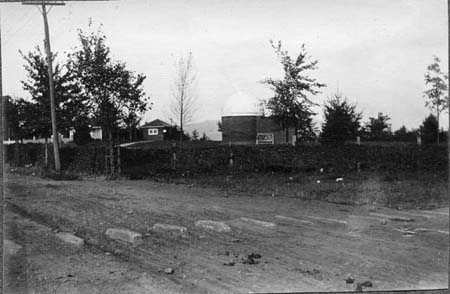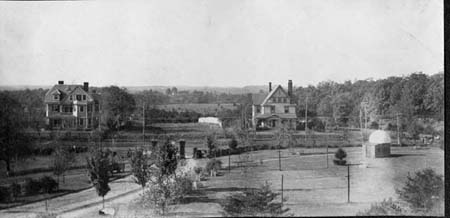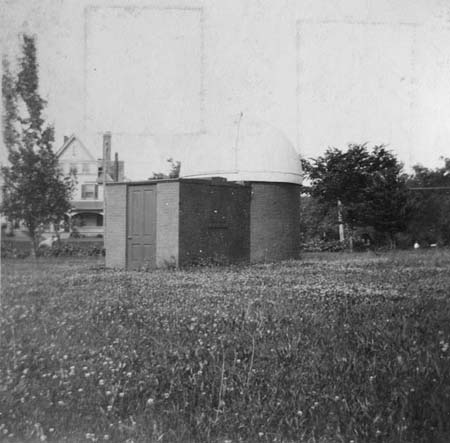| Major Christopher V. Winfree |
ABOUT WINFREE OBSERVATORY
Astronomy has been taught at Randolph-Macon Woman's College/Randolph College since the opening of the college in 1893. A small observatory was constructed in 1900, and our first telescope, a fine 6-inch refractor made by Brashear, was installed. The telescope's long brass tube was mounted on a metal pier. The 1901-02 college catalog included an astronomy course which featured "... a limited amount of observational work with the six-inch equatorial." Two years later, the 1903-04 catalog mentioned Winfree Observatory for the first time:
"By generous gift of the late Maj. C.V. Winfree an excellent six-inch equatorial telescope has been provided for astronomical observations. It is mounted in a separate building suitable for the purpose."
| Major Christopher V. Winfree |
Major Christopher V. Winfree was a prominent Lynchburg citizen and benefactor to Randolph-Macon Woman's College. He served on the college's board of trustees from 1890 until his death in 1902.
The original Winfree Observatory was a small, one-story, domed structure located on land now occupied by Smith Hall near the front campus entrance.
| RMWC in the early 1900's. The original observatory was located between Wright Hall and Rivermont Avenue where Smith Hall now stands. |
| The old observatory in 1902. | Check out the derby and mustache! | The observatory in 1921. |
Here are three more pictures of the old observatory:



The original small observatory was demolished to make way for the construction of Smith Hall during 1922-23. Smith Hall was completed in 1923, and, in that same year, a new, two-story, brick observatory building was also completed on the north side of campus. This building is our Winfree Observatory today. The 6-inch refractor was installed on its pier in the newly built observatory as seen below:
| The 6-inch Brashear refractor in the new observatory.(1954) |
The Bell dormitory parking lot, now located next to the observatory, was an athletic field in 1923. There were many fewer lights around the observatory in past years! Here's what the observatory and athletic field looked like in 1923:
| Winfree Observatory and the athletic field in 1923. |
RMWC students once competed in track and field events during an annual "Field Day" next to the observatory. Here are some other pictures which show the track, athletic field, and observatory in 1926:
| Looking toward the future site of Bell Dorm in 1926. | Winfree Observatory on Field Day in 1926. |
The observatory must have looked very much like the picture above in September, 1928 when 23 year-old Marguerite Risley first arrived on campus as an instructor of mathematics.
| Dr. Risley (1954). |
Dr. Risley, who later earned a Ph.D. in astronomy from Radcliffe, taught mathematics and astronomy at RMWC for 43 years until she retired in 1971. She had a particular interest in the motion of Mira variable stars, and was a member of the American Association of Variable Star Observers (AAVSO) from 1963 until her death in 1990. She was a member of the AAVSO council from October 1974 through October 1976. According to Janet Mattei, director of the AAVSO, Dr. Risley was, "a very dedicated teacher and astronomer, quiet and soft-spoken, with great insight and depth of knowledge. She was very interested in the contributions that amateur astronomers could make to professional astronomy, and was very supportive of the AAVSO and its relationship to the professional community."
| Dr. Risley with the 6-inch refractor in 1961. |
Dr. Risley used the 6-inch refractor until 1962 when she arranged for the purchase and installation of a new 12-inch Cassegrain telescope manufactured by Tinsley Laboratories.
| Dr. Risley with the 12-inch Cassegrain telescope.(1964) |
The 12-inch Cassegrain remained in service until August, 1985 when Dr. Michalik installed our present telescope, a 14-inch Celestron Schmidt-Cassegrain. By design, the newest telescope was operational in time for the 1986 apparition of Halley's comet.
Dr. Michalik began opening Winfree for public observing sessions in 1985. Regular monthly openings have continued during the academic year since then. These events have become quite popular in the local community. Thousands of visitors have enjoyed telescopic views of the Moon, Sun, planets, nebulae, star clusters, double stars, and galaxies. Public response is sometimes overwhelming during special events, like eclipses or bright comets, when local TV broadcasts live from the observatory, and hundreds of people wait hours in line for a brief look through the eyepiece.
It was at one of these public observing sessions that Dr. Michalik met a local Virginia gentleman and astronomy enthusiast, Bill Wright. Bill lives under relatively dark skies in Campbell County. Although he already owned a house full of telescopes, his telescopic thirst was not satisfied. In 1992 Bill purchased the old dismantled 6-inch and 12-inch telescopes then stored on Winfree's bottom floor. While Bill restored these to working order for his own enjoyment, Dr. Michalik used the money the college received to purchase an ST-6 CCD camera and the computer needed to operate it.
With the CCD camera attached to the 14-inch telescope, Winfree Observatory gained the ability to do modern photometric work. In December, 1993, after months of work installing equipment, fixing "bugs", and calibration, Dr. Michalik sent the first CCD stellar brightness measurements from Winfree Observatory to the American Association of Variable Star Observers (AAVSO). Since then the number of variable star measurements sent to the AAVSO from Winfree Observatory has grown to 4382.
During the 1993-94 academic year Dr. Michalik installed the first computerized pointing system on the telescope. A new, much needed Ash dome was also erected over the observatory in this year, replacing the 70 year-old black hulk dome which had become increasingly difficult to move and open. Next, during the 1994-95 academic year, Dr. Michalik installed an automated guiding system consisting of an 80 mm guide telescope, a drive corrector, and an ST-4 CCD camera. These devices made it easier to find celestial objects and keep them fixed in the field of view during long exposures. Observing efficiency increased tremendously as a result of these improvements.
| The 14-inch telescope on the original Celestron fork mount in 1998. |
| The black ST-6 CCD camera is mounted at the telescope's rear. |
| The 80 mm white guidescope is mounted parallel to the main telescope. |
Thanks to a generous bequest to the physics department by Isabel Boggs, a retired RMWC physics professor, Dr. Michalik was able to purchase and install a research-quality Paramount GT-1100 robotic telescope drive during the summer of 1999. Both the telescope and the CCD camera were then under full computer control.
| Isabel Boggs (1924) | Prof. Boggs (1947) |
| The 14-inch telescope on the Paramount GT-1100 robotic mount in 1999. |
In December, 2002 the ST-6 CCD camera was retired after nine years of productive use. It was replaced with a new ST-1001E CCD camera. A new motorized filter wheel and motorized focuser were also installed. An additional computer was added so that one computer controlled the Paramount GT-1100 telescope drive while the other computer controlled the CCD camera.
|
|
| The 14-inch telescope with the new ST1001E camera and filter wheel in 2002. |
In January, 2006 the Paramount GT-1100 was retired and a new Paramount ME mount was installed. Pointing accuracy has been much improved.
|
|
| The 14-inch telescope on the new Paramount ME mount in 2006. |
Winfree Observatory is presently used for a regular program of variable star observation with results sent in each month to the AAVSO. It is also regularly used for student research projects. Finally, the observatory serves as a valuable community resource during continuing public openings.
ABOUT THE FACILITIES:
Winfree Observatory consists of a two-story brick building covered by a motorized Ash
dome. It is located at 37 degrees 26 minutes north latitude, 79 degrees 10 minutes west
longitude, and approximately 720 feet above sea level. The telescope and observing room
are located on the second story. They are accessed by climbing an exterior wooden
staircase. Lights in the immediate vicinity of the observatory can be turned off using
specially installed switches under the dome.
| Winfree Observatory Today |
The main instrument is a 14-inch Celestron Schmidt-Cassegrain telescope. It is an f/11 device, with a focal length of 3910 mm. The telescope is mounted on a sturdy metal pier, which, in turn, is mounted on a brick and concrete pier that extends down from the second story all the way to the ground.
| The telescope pier. |
The presently inconvenient tall pier is left over from days prior to 1962 when it helped the original 6-inch refractor's long tube point towards the zenith. This tall pier is no longer needed, but the entire building was built around it. So we now have to climb portable ladders to reach the telescope. (This is good for burning calories! A night spent shivering in the cold while climbing up and down ladders usually results in loss of a pound or two! During one busy evening Dr. Michalik counted 166 trips up and down the ladder!)
Mounted parallel to the main telescope tube is a white Astrophysics 80 mm guidescope refractor as well as a smaller finderscope. A gray dewcap mounted on the end of the main tube helps prevent dew from forming on the front corrector lens. The dewcap also helps keep stray light from entering the tube.
| The 14-inch telescope on the (red) Paramount ME robotic mount. |
| The ST1001E CCD camera, filter wheel, and motorized focuser are mounted at the telescope's rear. |
Over the years a nice assortment of equipment for visual observing has been purchased including many fine single eyepieces, a binocular eyepiece, an f/7 focal length reducer/corrector, various filters for enhancing the contrast of planetary features, filters for reducing the effects of surrounding streetlights, an aluminized mylar solar filter for viewing sunspots, and a Daystar hydrogen-alpha filter for viewing solar prominences.
The telescope is mounted on a Paramount ME robotic telescope drive manufactured by Software Bisque. This research-quality, computer-controlled mount achieves high-accuracy telescope pointing and tracking. During a preliminary "mapping" session, the telescope is pointed at over one hundred stars spread evenly across the sky. The computer records any pointing errors during the "mapping" session, and then constructs a mathematical model to correct the errors. Through use of this mathematical model, the Paramount points to target objects with typical errors of only one arc minute or less! (One arc minute is one sixtieth of a degree!)
During an observing session, the observer selects a celestial object for viewing by clicking on the computer screen. The computer promptly displays the object's celestial coordinates along with lots more information. The observer then commands the telescope to slew to the target object. Stepper motors softly whine as the mount moves to the correct position. After a few seconds the target object is nearly centered in the eyepiece or CCD camera field of view!
Our ST-1001E CCD camera is manufactured by the Santa Barbara Instruments Group. It features a 1024 by 1024 pixel light sensitive chip. Each square pixel is 24 microns on a side. The chip contains 1,048,576 pixels and measures 24.6 mm on a side. The ST-1001E is a major step up from the original ST-6 CCD which had a 375 by 242 pixel chip containing only 90,750 pixels and measuring only 8.8 by 6.6 mm! During use the ST-1001E is thermoelectrically cooled to temperatures about 30 centigrade degrees below ambient temperature. One computer is dedicated to controlling the camera and recording the images while a second computer controls the Paramount ME telescope drive. The two computers are linked so images can be sent from one to the other for analysis. The ST-1001E is equipped with a motorized Optec filter wheel fitted with standard four-color broad-band photometric B (blue), V (visual, or green), R (red), and I (infrared) filters used for stellar photometry. The filters were purchased from Optec, Inc..
The ST-1001E camera has a little brother, the ST-4. Our ST-4 CCD camera is attached to the 80 mm guidescope. The ST-4 continually takes images through the guidescope, typically once every 20 seconds, and sends the images to its controlling "black box". The "black box" then detects any tiny motions of stellar images that might happen between consecutive exposures. (Star images drift because the telescope drive motor that keeps up with Earth's rotation might not be doing its job perfectly.) The "black box" then commands the drive motors to either speed up or slow down to correct for any ongoing image drift. The automatic guiding system allows long exposures of faint objects without image drift.
When the computer, CCD cameras, and automatic guiding system are all working together you hear quiet clicking and whirring. It's all very scientific looking, just like Hollywood's image of science, complete with dim blinking red lights.